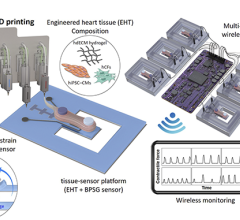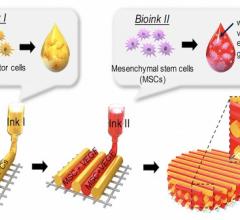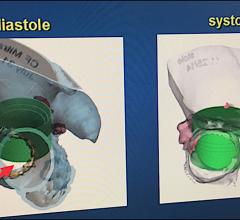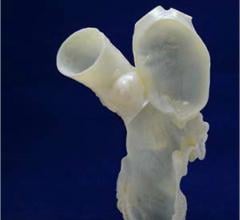
June 1, 2017 — More than 50 companies and organizations will display their latest products and services at the American Society of Echocardiography’s (ASE) 28th Annual Scientific Sessions, planned for June 2-6, 2017 in Baltimore.
Highlights from the show floor, as reported in their own words by the vendors, will include:
- The ASE Headquarters will feature nine new ASE products including guideline posters, pocket guides, and flip chart inserts on valvular regurgitation and stenosis as well as the Advanced Cardiac Sonographer Registry Review Guide, three new DVDs and two self-study programs. There will also be many opportunities in the ASE booth for attendees to talk with leadership on important topics like the Medicare Access and CHIP Reauthorization Act (MACRA), the Merit-based Incentive Payment System (MIPS) and other new healthcare policies, the new ASE ImageGuide Echo Registry, and how to achieve the FASE designation.
- The ASE Education and Research Foundation (ASEF) Booth is the central hub for all the foundation’s activities and initiatives. Attendees are encouraged to join in the Cardiovascular Challenge sponsored by StudyCast, the Chain Reaction Campaign, and enjoy and purchase the mission-based photos in the Images from the Heart Gallery. The Foundation has provided travel grants and scholarships for this year’s Scientific Sessions to 57 early career practitioners, totaling over $82,000.
- Philips is showcasing the new X8-2t Live 3D Transesophageal Transducer, the next generation of live 3-D transesophageal echo (TEE) for the Epiq ultrasound platform, with an improved acoustic design that is meant to work optimally with the imaging technology of EPIQ nSIGHT imaging. The X8-2t xMATRIX transesophageal transducer improves image quality in 2-D and live 3-D, with the company’s highest volume rates yet. The X8-2t features a configurable button on its handle, enabling fast and easy access when changing its functionality, even during the exam.
- Siemens Healthineers will showcase its Acuson SC2000 ultrasound system, Prime edition with new features recently cleared by the U.S. Food and Drug Administration (FDA). The system now features the eSie Flow quantification package, which enables clinicians to more confidently assess mitral regurgitation severity with simple quantification of inflow and outflow, quantify stroke volume from any valve or quantify intracardiac shunts, and quickly quantify regurgitant fraction pre- and post-procedure for more informed decisions.
- 3D D2P (DICOM to PRINT) software allows surgeons, radiologists, lab technicians and device designers to quickly create accurate, digital 3-D anatomical models from medical imaging data. These patient-specific models can be used for advanced visualization, 3-D printing, surgical planning and computer-aided detection (CAD). Unlike other competing products, D2P combines automated segmentation, mesh editing, connectivity with third party applications, high-quality volume rendering and mesh coloring in a single, affordable package. The advanced algorithms of the D2P software allow users to quickly and accurately segment bone, vascular, teeth and heart data from medical imaging files. Combining this capability with the additional features embedded in D2P, a broad range of medical professionals can easily create digital 3-D anatomical models within minutes without relying on third-party software or external services, with output formats that support a range of advanced, patient-specific applications.
- Studycast by Core Sound Imaging recently announced the release of Studycast Advisor. ASE released their Recommendations for Noninvasive Evaluation of Native Valvular Regurgitation in the April issue of the Journal of the American Society of Echocardiography (JASE). Studycast Advisor takes the 85 pages of ASE guidelines and prompts the physician to let them know that based on the quantitative and semi-quantitative data available in the Studycast worksheet, valvular regurgitation may be indicated, and to what degree.
- Digisonics will showcase new functionality including a virtual desktop infrastructure (VDI) platform for increased security, availability and remote reading access, greatly enhanced image transmission performance, billing automation with quality control (QC) for quicker reimbursement, new interfaces to advanced imaging analysis software and a robust data mining and business analytics package to streamline accreditation requirements and management reporting.
- Ke Labs, makers of the Echo Test and Teach echocardiography simulator, will be providing a sneak peek at their new web-based simulator, which will enable anyone with a browser and Internet access to take echocardiography training. Additionally, Ke Labs will highlight significant case improvements aimed at accommodating a wider audience, such as sonographers in training, cardiology fellows and non-cardiologists who provide point-of-care echocardiography.
- The European Association of Cardiovascular Imaging (EACVI) is announced the release of 10 new state-of-the-art didactic tutorials in TEE, bringing the total number to 16. The EACVI e-learning program includes 57 tutorials, 30 recommendations and textbook chapters and 27 lectures from EACVI meetings and congresses. Based on the EACVI Core Syllabi, it prepares for EACVI certification. It is currently available for echocardiography (transthoracic echo [TTE] and TEE) and cardiac magnetic resonance (CMR). By end of this year, it will also cover nuclear cardiology and cardiac computed tomography (CT).
- Heritage Medical Products will feature the Phoenix, an articulating arm support device for sonographers. This is a 360-degree articulating arm support that will sustain 100 percent of the weight of the arm. The Phoenix helps to protect sonographers’ back, shoulder and neck area while scanning. This allows for a complete free range of motion and helps to prevent repetitive motion injuries.
- Cardiology practices and heart programs face a growing number of challenges — from declining financial performance and alignment issues to new payment models — in today’s rapidly changing era of health care. The IMPACT: Heart Program Opportunities Assessment is a customized two-day evaluation conducted by MedAxiom’s consulting team to identify and prioritize top opportunities for improvement and recommended next steps. The company will assess: alignment and engagement; strategy and implementation, physician/APP workforce; clinic and scheduling operations; practice and CVSL performance; clinical, financial and operational aspects; governance effectiveness; and change readiness.
- Merge, an IBM company, will highlight its Cardiology Solution along with future solutions for customized reporting and analytics. The company will also showcase its first cognitive solution from Watson Health's medical imaging business, IBM Watson Imaging Clinical Review, a cognitive data review tool that can be used to detect and enable the reconciliation of differences between clinical diagnosis and the patient’s electronic medical record (EMR) problem list and recorded diagnosis.
- Representatives from Medical Positioning Inc. (MPI) will demonstrate the capabilities of the company’s newest product, the EchoBed X. The ergonomic platform, designed for echocardiogram imaging, features a 19– 38-inch height range, meeting the Americans with Disabilities Act (ADA) low height standard for patient transfer. Other improved features include an increased patient weight capacity of 600 pounds, a static load capacity of 1,000 pounds, barrier-free edges with hideaway handrail brackets and improved hand controls.
- ScImage will highlight PICOM365 picture archiving and communication system (PACS) with key features including: VPN-less imaging, which allows users to simply and securely share patient data across the enterprise or outside their network without VPN and port exposure; Multi-factor authentication for an added level of security, where each device must be properly identified and registered with user credentials before accessing PICOM365 services; and the Microsoft Azure Cloud platform on which PICOM365 is built. It provides security, scalability, bandwidth and resiliency along with proactive advanced threat analytics.
- Sheehan Medical will introduce Real Ultrasound, a line of simulators that display real patient images in real-time. For transesophageal echo (TEE), the company offers a real probe and probe passage experience. The simulators allow trainees to practice in private, self-paced, while receiving immediate feedback on progress in every patient case. Faculty save their time for teaching the nuances of image interpretation, not basic image acquisition. The company’s validated skill metrics inform faculty of each trainee’s preparation to scan live patients. The transthoracic echo (TTE) simulator trains providers at all levels from sonography/medical student to resident/fellow to physicians/nurses in practice.
- Tomtec is featuring Tomtec Zero, the first fully diagnostic cardiovascular software solution. Accessible through web browsers, the next-generation zero-footprint viwer breaks down the barriers imposed by traditional workstations and allows greater freedom with remote reading possibilities. With Tomtec Zero, every physician reading cardiology studies at locations like the office, reading room, ward or from home, has full diagnostic access to all images and relevant clinical tools, including automated strain measurements. Cardiologists will now be able to review images on mobiles devices at any time. Referring physicians can instantly access reports and studies to get results rapidly from the cardiologist. Surgeons and anesthesiologists are able to review clinical data on laptops or tablets for surgical planning away from their usual workstation. Satellite locations can collaborate with expert readers from the central site to deliver excellent patient care.
- Unetixs offers noninvasive vascular diagnostic systems available with options that include networking and reporting software, DICOM/PACS and LAN/WAN compatibility.
In addition, five Science & Technology Theater sessions will offer the latest information from an industry perspective. These special breakfast and lunch sessions are not part of the official ASE 28th Annual Scientific Sessions, as planned by the Program Committee, but showcase industry advances.


 October 21, 2024
October 21, 2024 









